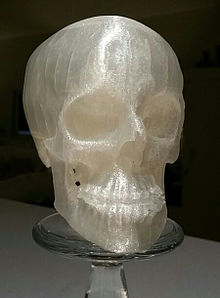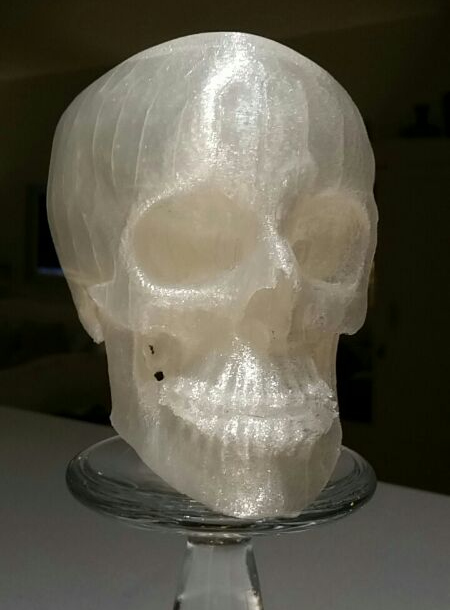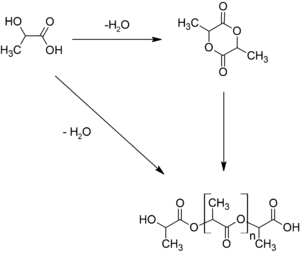Polylactic acid – Wikipedia
Poly(lactic acid) or polylactic acid or polylactide (PLA) is a biodegradable and bioactive thermoplastic aliphatic polyester derived from renewable resources, such as corn starch (in the United States and Canada), cassavaroots, chips or starch (mostly in Asia), or sugarcane (in the rest of the world).
In 2010, PLA had the second highest consumption volume of any bioplastic of the world. The name “polylactic acid” does not comply with IUPAC standard nomenclature, and is potentially ambiguous or confusing, because PLA is not a polyacid (polyelectrolyte), but rather a polyester.
Production
Producers have several industrial routes to usable (i.e. high molecular weight) PLA. Two main monomers are used: lactic acid, and the cyclic di-ester, lactide. The most common route to PLA is the ring-opening polymerizationof lactide with various metal catalysts (typically tin octoate) in solution, in the melt, or as a suspension. The metal-catalyzed reaction tends to cause racemization of the PLA, reducing its stereoregularity compared to the starting material (usually corn starch).
Another route to PLA is the direct condensation of lactic acid monomers. This process needs to be carried out at less than 200°C; above that temperature, the entropically favored lactide monomer is generated. This reaction generates one equivalent of water for every condensation (esterification) step. The condensation reaction is reversible and subject to equilibrium, so removal of water is required to generate high molecular weight species. Water removal by application of a vacuum or by azeotropic distillation is required to drive the reaction toward polycondensation. Molecular weights of 130 kDa can be obtained this way. Even higher molecular weights can be attained by carefully crystallizing the crude polymer from the melt. Carboxylic acid and alcohol end groups are thus concentrated in the amorphous region of the solid polymer, and so they can react. Molecular weights of 128–152 kDa are obtainable thus.
Polymerization of a racemic mixture of L- and D-lactides usually leads to the synthesis of poly-DL-lactide (PDLLA), which is amorphous. Use of stereospecific catalysts can lead to heterotactic PLA which has been found to show crystallinity. The degree of crystallinity, and hence many important properties, is largely controlled by the ratio of D to L enantiomers used, and to a lesser extent on the type of catalyst used. Apart from lactic acid and lactide, lactic acid O-carboxyanhydride (“lac-OCA”), a five-membered cyclic compound has been used academically as well. This compound is more reactive than lactide, because its polymerization is driven by the loss of one equivalent of carbon dioxide per equivalent of lactic acid. Water is not a co-product.
The direct biosynthesis of PLA similar to the poly(hydroxyalkanoate)s has been reported as well.
Another method devised is by contacting lactic acid with a zeolite. This condensation reaction is a one-step process, and runs about 100 °C lower in temperature.
Manufacturers
As of June 2010, NatureWorks was the primary producer of PLA (bioplastic) in the United States. The second biggest producer of PLA in the world is the weforyou Group with an annual capacity of pure PLA and compounds of 50,000t. Other companies involved in PLA manufacturing are Evonik Industries (Germany), Corbion PURAC Biomaterials (The Netherlands) who have announced a new 75,000 ton PLA plant in Thailand by 2018, and several Chinese manufacturers. The primary producer of PDLLA is Evonik Industries and Corbion PURAC. The Resomer brand of PDLLA is produced in the Health and Nutrition business segment. Corbion PURAC is a listed company in the Netherlands, and operating plants worldwide, and the only producer of PDLA, produced from the D-isomer of lactid acid. Galactic and Total Petrochemicals operate a joint venture, Futerro, which is developing a second generation polylactic acid product. This project includes the building of a PLA pilot plant in Belgium capable of producing 1,500 tonnes/year.
Due to the chiral nature of lactic acid, several distinct forms of polylactide exist: poly-L-lactide (PLLA) is the product resulting from polymerization of L,L-lactide (also known as L-lactide). PLLA has a glass transition temperature 60–65 °C, a melting temperature 173–178 °C and a tensile modulus 2.7–16 MPa. Heat-resistant PLA can withstand temperatures of 110 °C. PLA is soluble in chlorinated solvents, hot benzene, tetrahydrofuran, and dioxane.
Polylactic acid can be processed like most thermoplastics into fiber (for example, using conventional melt spinning processes) and film. PLA has similar mechanical properties to PETE polymer, but has a significantly lower maximum continuous use temperature. The tensile strength for 3-D printed PLA was previously determined.
The melting temperature of PLLA can be increased by 40–50 °C and its heat deflection temperature can be increased from approximately 60 °C to up to 190 °C by physically blending the polymer with PDLA (poly-D-lactide). PDLA and PLLA form a highly regular stereocomplex with increased crystallinity. The temperature stability is maximised when a 1:1 blend is used, but even at lower concentrations of 3–10% of PDLA, there is still a substantial improvement. In the later case, PDLA acts as a nucleating agent, thereby increasing the crystallization rate. Biodegradation of PDLA is slower than for PLA due to the higher crystallinity of PDLA.
There is also poly(L-lactide-co–D,L-lactide) (PLDLLA) – used as PLDLLA/TCP scaffolds for bone engineering.
Solvent welding
PLA can be solvent welded using dichloromethane.
Applications

Mulch film made of PLA-blend “bio-flex”

Biodegradable PLA cups in use at a restaurant

Tea bags made of PLA. Peppermint tea is enclosed.

PLA can be processed by extrusion such as 3d printing, injection molding, film and sheet casting, and spinning, providing access to a wide range of materials.

3D Printed Human skull with data from Computed Tomography. Transparent PLA.
PLA is used as a feedstock material in desktop fused filament fabrication 3D printers (e.g. RepRap). PLA printed solids can be encased in plaster-like moulding materials, then burned out in a furnace, so that the resulting void can be filled with molten metal. This is known as “lost PLA casting”, a type of investment casting.
Being able to degrade into innocuous lactic acid, PLA is used as medical implants in the form of anchors, screws, plates, pins, rods, and as a mesh. Depending on the exact type used, it breaks down inside the body within 6 months to 2 years. This gradual degradation is desirable for a support structure, because it gradually transfers the load to the body (e.g. the bone) as that area heals. The strength characteristics of PLA and PLLA implants are well documented.
PLA can also be used as a decomposable packaging material, either cast, injection-molded, or spun. Cups and bags have been made from this material. In the form of a film, it shrinks upon heating, allowing it to be used in shrink tunnels. It is useful for producing loose-fill packaging, compost bags, food packaging, and disposable tableware. In the form of fibers and nonwoven fabrics, PLA also has many potential uses, for example as upholstery, disposable garments, awnings, feminine hygiene products, and diapers. Thanks to its bio-compatibility and biodegradability, PLA has also found ample interest as a polymeric scaffold for drug delivery purposes.
Racemic and regular PLLA has a low glass transition temperature, which is undesirable. A stereocomplex of PDLA and PLLA has a higher glass transition temperatures, lending it more mechanical strength. It has a wide range of applications, such as woven shirts (ironability), microwavable trays, hot-fill applications and even engineering plastics (in this case, the stereocomplex is blended with a rubber-like polymer such as ABS). Such blends also have good form stability and visual transparency, making them useful for low-end packaging applications. Pure poly-L-lactic acid (PLLA), on the other hand, is the main ingredient in Sculptra, a long-lasting facial volume enhancer, primarily used for lipoatrophy of cheeks. Progress in biotechnology has resulted in the development of commercial production of the D enantiomer form, something that was not possible until recently.
PLA is also used in e-tobacco industry. Philip Morris’s iQOS heets, includes PLA to slow the vapour down without absorbing it, giving it time to cool to a more pleasant temperature before inhaling it.
Recycling

PLA has SPIresin ID code 7
Currently, the SPI resin identification code 7 (“others”) is applicable for PLA. In Belgium, Galactic started the first pilot unit to chemically recycle PLA (Loopla). Unlike mechanical recycling, waste material can hold various contaminants. Polylactic acid can be recycled to monomer by thermal depolymerization or hydrolysis. When purified, the monomer can be used for the manufacturing of virgin PLA with no loss of original properties (cradle-to-cradle recycling).
Degradation
Amycolatopsis and Saccharotrix are able to degrade PLA. A purified protease from Amycolatopsis sp., PLA depolymerase, can also degrade PLA. Enzymes such as pronase and most effectively proteinase K from Tritirachium album degrade PLA.
Pure PLA foams undergo selective hydrolysis when placed in an environment of Dulbecco’s modified Eagle’s medium (DMEM) supplemented with fetal bovine serum (FBS) (a solution mimicking body fluid). After 30 days of submersion in DMEM+FBS, a PLLA scaffold lost about 20% of its weight.



Comments are closed.